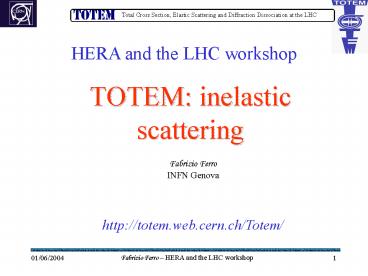TOTEM: inelastic scattering - PowerPoint PPT Presentation
1 / 18
Title:
TOTEM: inelastic scattering
Description:
Total Cross Section, Elastic Scattering and Diffraction Dissociation at the LHC ... Elastic Scattering and Diffraction Dissociation at the LHC. Charged flux ... – PowerPoint PPT presentation
Number of Views:157
Avg rating:3.0/5.0
Title: TOTEM: inelastic scattering
1
TOTEM inelastic scattering
HERA and the LHC workshop
Fabrizio Ferro INFN Genova http//totem.web.cer
n.ch/Totem/
2
Outline
- Inelastic detectors general considerations,
simulation and ongoing studies - Inelastic scattering general considerations and
studies published in the TDR - Future plans a proposal for an Inelastic
scattering working group
3
TOTEM inelastic detectors
- Inelastic detectors
- T1 CSC Coverage 3lt?lt5
- T2 GEM Coverage 5lt?lt7
TOTEM inelastic detectors are trackers which have
been designed to discriminate between beam-beam
events and background (eg. beam-gas) events by
means of the primary vertex reconstruction.
4
T1
- CSC trigger (signal from anode wires) and
reconstruction of the primary vertex. (5 planes
and measurement of 3 coordinates per plane). - planes 3deg rotated w.r.t. each other to easy
pattern recognition
Support connected to CMS
5
T2
- Placed at 13.5m from IP. GEM (Gas Electron
Multiplier) technology to cope with the high
rates and high radiation doses (see HERA-B,
COMPASS).
6
T2 single plane
- 54(j) x 22(h) 1188 pads
- Pads Dh x Dj 0.06 x 0.18p
- 2x2 mm2 __ 7x7 mm2
- Strips 256 (width 80 mm,pitch 400 mm)
Pads with digital read-out
Electric field
Circular strips with analogue read-out
7
T1 and T2 simulation and performance
- The simulation of the inelastic detectors is done
in the CMS framework (OSCAR). This allows to
generate and analyze datasets also for the common
CMS/TOTEM physics program. - The simulation is Geant4 based.
- 100000 minimum bias, double and single
diffractive events have been generated (Pythia). - This allowed to test the reconstruction
capability of the telescopes and to estimate the
background due to secondary interactions in the
beampipe and due to the beamgas events.
8
T1 and T2 simulation and performance
- Geometrical acceptance
- Pattern recognition
- Track fit
- Vertex fit
Primary vertex resolution is sufficient for
discriminating between beam-beam and beam-gas
events.
9
Charged flux
Int. flux at 500 fb-1
(M.Huhtinen)
T1 and T2 will have to withstand a large charged
flux. T1 1.5 Hz/cm2 T2 gt100 Hz/cm2 at
L1028 T1 and T2 will be able to operate up to
L1032. Probably more for T2.
T2
10
Pattern recognition studies
Example (T2)
Hits in the 1st plane
- Main aim find track candidates and evaluate
event multiplicity. - Method group hits in roads to reduce hit
combinations and to simplify track fitting. - Idea tracks coming from the interaction point
travel with constant ? and f (magnetic field
off). - Procedure project on a ?-f plane the hits of the
detector 5 planes.
primaries
primaries
11
Measurement of ?tot
- Measurement of the total cross section with the
luminosity independent method using the Optical
Theorem.
Measurement of the elastic and inelastic rate
with a precision better than 1.
12
Inelastic cross section
- Event selection
- trigger from T1 or T2 (double arm o single arm)
- Vertex reconstruction (to eliminate beam-gas
bkg.) - Extrapolation for diffractive events needed
Lost events
simulated
extrapolated
Acceptance
detected
Loss at low masses
Pythia generator
13
Total cross section
(sinel.80mb, sel.30mb)
Losses (mb)
1
14
CMS/TOTEM
- T1 and T2 will be able to run as subdetectors
of CMS - A common CMS/TOTEM physics program on diffraction
is going to be defined in details. - For the first time at a collider large
acceptance detector which measures the forward
energy flow - 1 day run at large beta (1540m)
- and L1029cm-2s-1
- 100 million minimum bias events,
- including all diffractive processes
- gt90 of all diffractive
- protons are detected
15
Level-1 Trigger
L1028cm-2 s-1
All the following trigger typologies will need
T1/T2.
16
Luminosity 210 29 cm -2 s -1 Data taking for
soft diffraction 20 mb 4 kHz
410 8 events / 1 eff. Day Double Pomeron 1 mb
210 7 events / 1 eff. Day Precise study
of soft diffraction phenomena Luminosity 10 31
cm -2 s -1 Few day runs with 4 10 5 s
4 10 36 cm -2 4000 evts /
nb Double Pomeron exchange High masses order of
TeV ?c 10 6-7 events before decay ?b
10 3-4 events before decay Large pt
di jets coplanar dijet with two
accompanying protons and nothing else Single
diffraction with high pt jets and leptons Study
of rapidity gaps with identified protons
17
Proposal for a working group on inelastic
scattering
- Main aim to facilitate the simulation tasks
necessary for the physics feasibility studies - Some issues
- To complete the implementation, in the CMS
software, of the detector digitization and
reconstruction tools - To study in details the capability of the
detectors of doing a pointing trigger - To study how to use elastic and inelastic
scattering simulations together - To study the possibility of identifying rapidity
gaps with T2 - To understand how T2 (and T1) can contribute in
the study of interesting physics channels (e.g.
?c) - Suggestions are welcome foward jets,
mini-jets, multiple rap gaps,..
18
(No Transcript)































